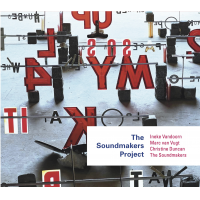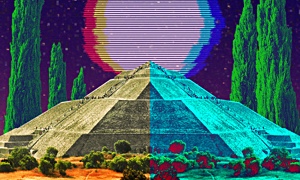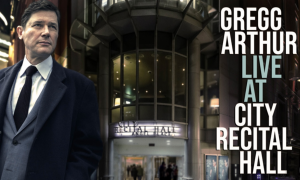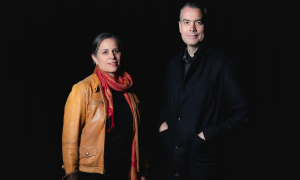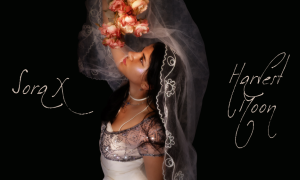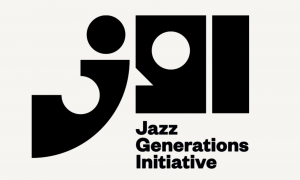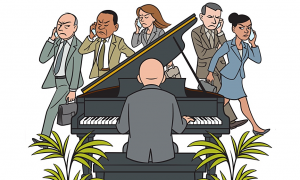On a recent afternoon, a dozen cinematographers, directors and camera assistants huddled inside a sound stage on the Sony Pictures lot in Culver City, wearing black plastic glasses as they watched a monitor.
The object of their gaze: the body movements of a USC acting student sitting at a kitchen table on a set a few yards away.
“Hold up one finger,” bellowed the instructor, cinematographer David Drzewiecki.
The student obliged as a technician several yards away used a remote-control device to adjust the position and angle of the left and right lenses (one for each eye) of a 3-D camera rig on rollers. The finger gradually protruded from the monitor screen while the kitchen background faded into a blur.
This is Hollywood's 3-D frenzy, from ground level.
Directors and cinematographers are mastering new skills and equipment. Studio executives are scouring their movie slates and their libraries for films with the potential to be released in 3-D. Technology companies that provide 3-D equipment and services are hiring new workers. Theater operators are taking out loans to convert projection rooms to the digital technology.
All this to give filmgoers a “new" experience and collect an extra $3 to $5 per ticket.
As with every hot trend in Hollywood, it's uncertain whether the 3-D onslaught is simply a flash, like the push in the 1980s to colorize black-and-white films, or a fundamental transformation akin to the advent of sound in the 1920s.
“The real question now is: How many movies per year does the audience want to put on glasses and pay a premium for?' “ said Rob Moore, vice chairman of Paramount Pictures.
Hollywood rarely does anything unless it overdoes it. Warner Bros. President Alan Horn recently said that 3-D will be standard for its big-event movies. In all, 19 films will be released in 3-D this year, up from five in 2008.
“If you're pitching event movies to a studio and you're not at least prepared to discuss the possibility of shooting in 3-D, you're going to be severely handicapped," said Marty Bowen, producer of the “Twilight" films.
Cinematographer Irek Hartowicz had no intention of taking a class on how to shoot in 3-D until producers of his next project, a “comedy" set against the French invasion of Russia in 1812, changed plans. “Our production was in 2-D and suddenly, after the whole boom of Avatar,' producers strongly began to think about shooting in 3-D because the market is so huge,” said Hartowicz, who attended the three-day Sony class.
“We're not allowed to train on the job, so we have to get it right the first time," said Mark Weingartner, chair of the national training committee for the International Cinematographers Guild, which helped Sony develop the class at the studio's new 3-D training center. “We're trying to prepare our members for this 3-D tsunami."
The goal is to train a “community of experts" and build a better understanding of the new technology. “We're trying to cure the fear of the unknown,” said the center's senior vice president, Buzz Hays.
For directors, the new medium can be a challenge. They need to imagine scenes in three dimensions and create longer, slower shots, because the technology isn't suited to rapid cutting. “I felt like I was making my first movie again,” said Paul W.S. Anderson, a veteran horror film director and producer who recently shot “Resident Evil: Afterlife" in 3-D. “Suddenly, you have this whole new palette."
This isn't the first time Hollywood has tried to persuade moviegoers to don glasses, of course. Stereoscopic cinema first became popular in the 1950s with such horror flicks as “Creature From the Black Lagoon." High costs and technology problems or perhaps just campy filmmaking curbed its appeal, until a brief resurgence in the 1980s.
Then “Avatar" took the nation by storm, running up grosses of $2.7 billion worldwide, so far. A staggering 83% of “Avatar's" domestic ticket sales revenue came from theaters where moviegoers paid extra to put on 3-D glasses.
The object of their gaze: the body movements of a USC acting student sitting at a kitchen table on a set a few yards away.
“Hold up one finger,” bellowed the instructor, cinematographer David Drzewiecki.
The student obliged as a technician several yards away used a remote-control device to adjust the position and angle of the left and right lenses (one for each eye) of a 3-D camera rig on rollers. The finger gradually protruded from the monitor screen while the kitchen background faded into a blur.
This is Hollywood's 3-D frenzy, from ground level.
Directors and cinematographers are mastering new skills and equipment. Studio executives are scouring their movie slates and their libraries for films with the potential to be released in 3-D. Technology companies that provide 3-D equipment and services are hiring new workers. Theater operators are taking out loans to convert projection rooms to the digital technology.
All this to give filmgoers a “new" experience and collect an extra $3 to $5 per ticket.
As with every hot trend in Hollywood, it's uncertain whether the 3-D onslaught is simply a flash, like the push in the 1980s to colorize black-and-white films, or a fundamental transformation akin to the advent of sound in the 1920s.
“The real question now is: How many movies per year does the audience want to put on glasses and pay a premium for?' “ said Rob Moore, vice chairman of Paramount Pictures.
Hollywood rarely does anything unless it overdoes it. Warner Bros. President Alan Horn recently said that 3-D will be standard for its big-event movies. In all, 19 films will be released in 3-D this year, up from five in 2008.
“If you're pitching event movies to a studio and you're not at least prepared to discuss the possibility of shooting in 3-D, you're going to be severely handicapped," said Marty Bowen, producer of the “Twilight" films.
Cinematographer Irek Hartowicz had no intention of taking a class on how to shoot in 3-D until producers of his next project, a “comedy" set against the French invasion of Russia in 1812, changed plans. “Our production was in 2-D and suddenly, after the whole boom of Avatar,' producers strongly began to think about shooting in 3-D because the market is so huge,” said Hartowicz, who attended the three-day Sony class.
“We're not allowed to train on the job, so we have to get it right the first time," said Mark Weingartner, chair of the national training committee for the International Cinematographers Guild, which helped Sony develop the class at the studio's new 3-D training center. “We're trying to prepare our members for this 3-D tsunami."
The goal is to train a “community of experts" and build a better understanding of the new technology. “We're trying to cure the fear of the unknown,” said the center's senior vice president, Buzz Hays.
For directors, the new medium can be a challenge. They need to imagine scenes in three dimensions and create longer, slower shots, because the technology isn't suited to rapid cutting. “I felt like I was making my first movie again,” said Paul W.S. Anderson, a veteran horror film director and producer who recently shot “Resident Evil: Afterlife" in 3-D. “Suddenly, you have this whole new palette."
This isn't the first time Hollywood has tried to persuade moviegoers to don glasses, of course. Stereoscopic cinema first became popular in the 1950s with such horror flicks as “Creature From the Black Lagoon." High costs and technology problems or perhaps just campy filmmaking curbed its appeal, until a brief resurgence in the 1980s.
Then “Avatar" took the nation by storm, running up grosses of $2.7 billion worldwide, so far. A staggering 83% of “Avatar's" domestic ticket sales revenue came from theaters where moviegoers paid extra to put on 3-D glasses.










